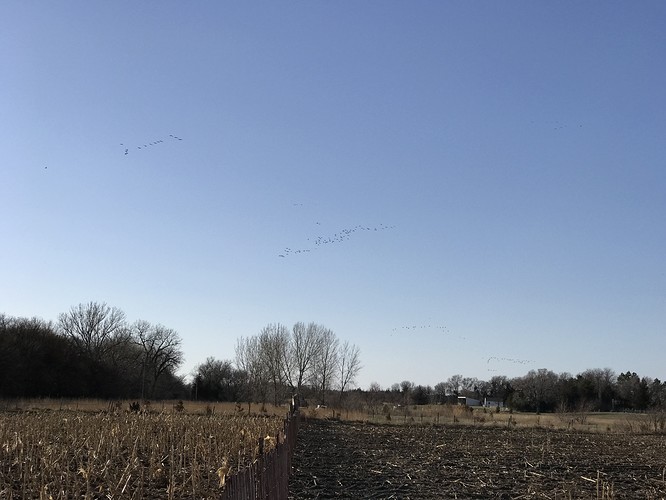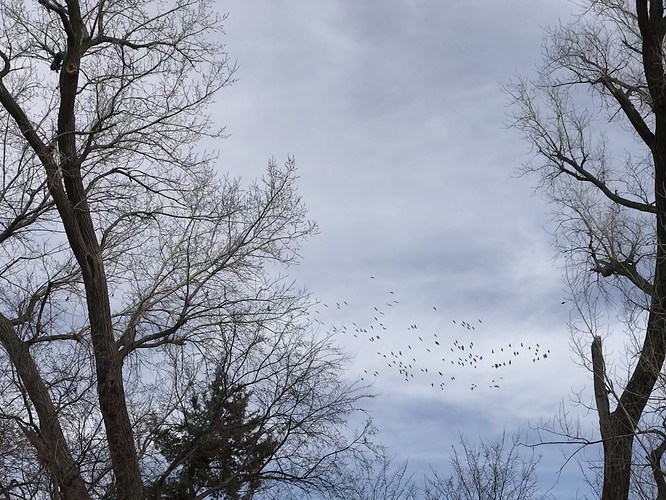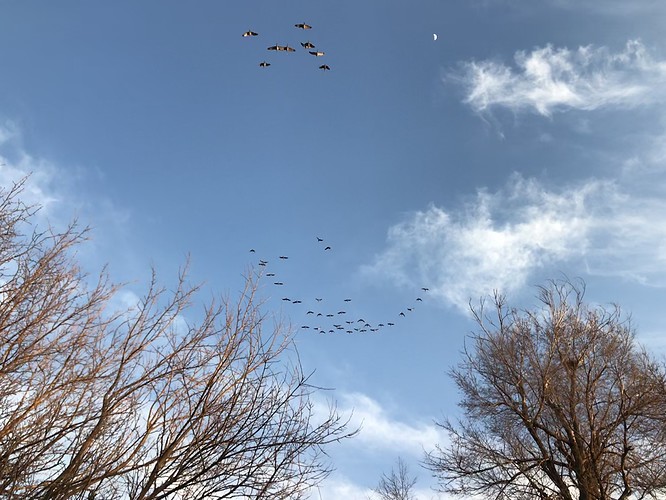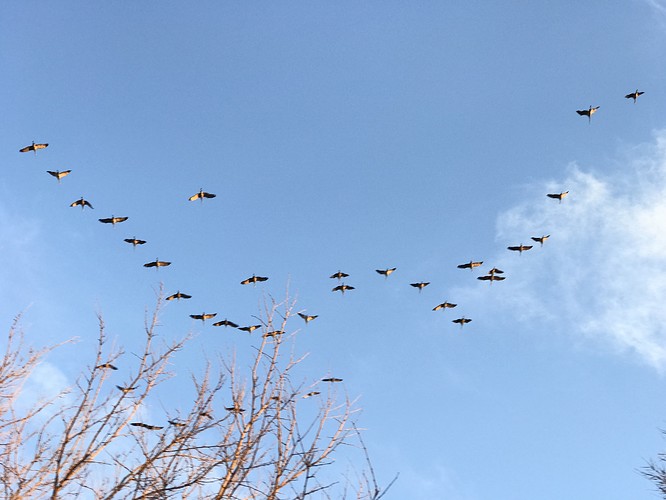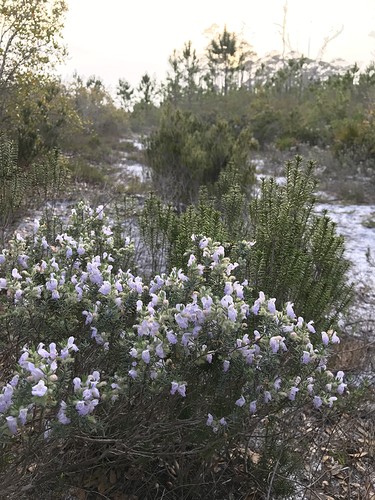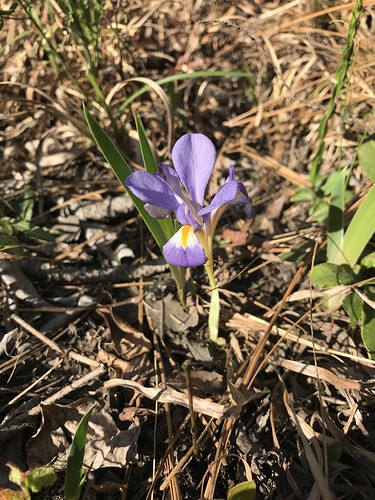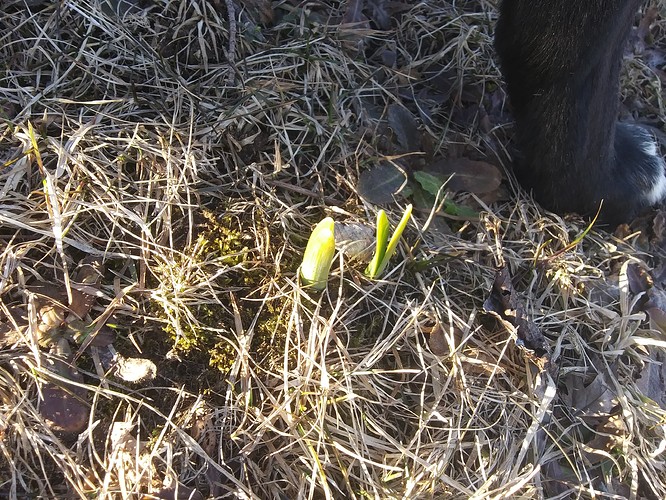I heard Sandhills cranes flying over last week heading north. Never did see them.
Took this photo in the garden today on a brisk almost-Spring day. We did get rain finally this past week. Not a lot but it did wake up some plants. I guess I like this photo because it makes me think of nature more than a garden.
Lovely framing between the silver birch trees. I wouldn’t have thought it was a garden if you haven’t have said. Very Edenic.
My garden is a little more Genesis 3… “It will produce thorns and thistles for you,” 
Then again my climate is more Edenic even if plagued occasionally by drought.
Something new is happening in my garden that is pretty interesting. I have two of a Echium hybrid growing in my side garden which are about the same size, maybe ten feet tall. These normally grow on a biennial schedule like foxglove. Echiums are prone to fasciation but I’ve never had one of these do it until now. Fasciation or cresting, according to wiki, Fasciation (pronounced /ˌfæʃiˈeɪʃən/, from the Latin root meaning “band” or “stripe”), also known as cresting , is a relatively rare condition of abnormal growth in vascular plants in which the apical meristem (growing tip), which normally is concentrated around a single point and produces approximately cylindrical tissue, instead becomes elongated perpendicularly to the direction of growth, thus producing flattened, ribbon-like, crested (or “cristate”), or elaborately contorted tissue. For whatever reason this one didn’t start cresting until it was already several feet tall at which point the stem started getting wider. So yesterday I set up an 8 foot ladder and took this photo

This morning I tried again by holding the camera out as far as I could I captured some images of what was going on up there.

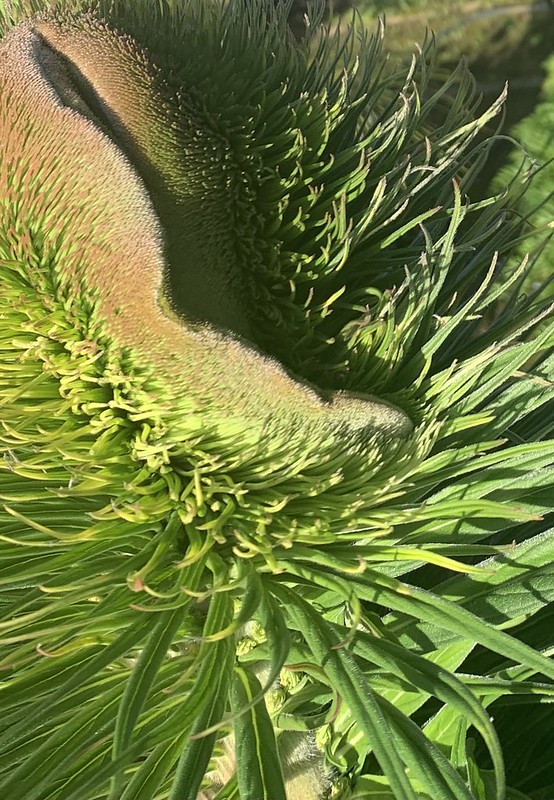
Here they are together. The only tip off was the widening out at the top of the one the left.

For comparison’s sake here is what the growing tip of the normal one is doing.

My gardening friends are speculating on what might become of the flowers. My garden designing neighbor thinks it may not flower at all, which would be alright with me since its vegetative growth is far more fascinating to me. But here from last year is what they normally do.

This makes me think of how HOX genes turn on or turn off growth in the womb for our kind. I suppose the development of a plant goes on for most of its life.
Yesterday and Friday were good days for taking down snow fence with several thousand sand hill cranes as company and pleasant background music.
Friday late afternoon, four sizable groups (or other collective noun you might use: “construction”, “dance”, “sedge”, “siege”, and “swoop”  ):
):
Lunchtime yesterday, one smaller group of the multiple dozens that flew over:
Near sunset, with sunlight under their wings giving an almost startling strobe light effect when they flapped (with a half moon above):
Another:
‘Just’ nice clouds near sunset:
Ok like those clouds in the last photo but look at all the cranes!
The first imagine is the very beautiful red maple wings. The seeds are actually edible though unless I had nothing else to eat I personally can’t justify the time to get them out. The wings are not edible, just the seed and they are about the size of a shelled sunflower seed. Kind of a bean taste and can be eaten raw. Ive eaten a lot, but mostly just to do it showing others.
The second is a shot of a trail I was hiking a few days ago. It was really lovely. It was maybe the last day of winter. I like it because if you don’t know better it always looks like a snowy landscape. But it’s not. It was 81°f. The soil is pretty much almost completely sand. The trees are the lovely flowers of the black Titi tree. In the south it’s a evergreen and has a light floral scent but because the flowers are on trees and the trees are a dominating and common tree, sometimes thousands blooming at once, the floral smell is just all over. The smaller whitish pale purple flowers are the false rosemaries. The flowers give the impression of frosted plants. But it’s very warm.
The third picture is the false rosemary blooming next to the Sandhill rosemary ( though it looks like a conifer it actually a angiosperm ).
I believe the fourth picture shows a Virginia Blue Iris. I’m not an iris specialist though. There are about 15 species in my county I think and it’s a mix of native and nonnative but the blue iris is not in my county. But the Virginia blue / flag iris is.
Crazy about maple trees wing nut seeds.
Looks like you are all in full swing of Spring. Today, the March sun was shining in West Michigan, it was 60 degrees, and if you check a maple twig a few hours after breaking it, enough sweet sap drips out that my kids can lick and appreciate the flavor. We have a few daffodils just starting to sprout, but the bare trees form a stark net against the Sun as it rises and sets. I don’t see any buds opening yet. We usually can expect a couple of heavy snowfalls yet, with the last one in mid April. I enjoy your photos!
As in you like to eat them , or they are really beautiful or crazy they can be eaten? I’m not sure how to interpret it lol.
Yeah I just like how they look. I took pictures of one at Butchart gardens in Victoria a few years ago that were amazingly bright red.
Finally remembered to go back and find that photo taken in the fall 2018 in Victoria.
THOSE ARE ENORMOUS! Wow, I’e never seen a plant like that before.
I have a soft spot for freaky plants. In better (wetter) conditions these can get bigger still. Mine is a cross between E. pininana (the largest one) and E. wildpretii (a smaller one). This is the taller parent growing in a friend’s San Francisco garden under ideal conditions. They’re on flanks of Mount Sutro and get more rain and fog than most places.
This is the other parent, E. wildpretii, taken by another friend. It was pretty big at 7 or 8 feet tall. The cross I’m growing (as volunteers) is called ‘Mr Happy’. They sometimes get to 16 or 18 feet tall for me in Berkeley.
They basically form a large (wide) rosette the first year and then send up the flower the next. Then it dies or sometimes lingers on another season but much diminished.
Wow!
My first reading obsession in middle school was zoology and everything to do animals. Unfortunately it is harder to meet all of an animal’s requirements, and who has room for megafauna? Not me. But now I’m all about the plants. Very few restrictions on growing what you like and can get hold of. There are things I can’t grow or can’t grow well because they need a colder winter or really hot summers. We’re not tropical here and I do lose plants to freeze some years, though less and less, and I never take cuttings to over winter anymore. But it is a very forgiving climate.
I tried looking of that species near me and had none. There are not even any in that genus native to where I live. But I found a few others in the same family, but definitely nothing as catchy as that.
Do you by any chance know the term used for its form? I’ll continue looking though. I’ll try to find some landscaping journals to look through how well behaved they are in gardens for my area or are they a potential major spreader. But maybe there are some sterile hybrids.
Though if they are biannuals, almost makes it a useless and impossible task lol.
Cranes have taken the place of snow fence in the field, and cottonwood leaves are budding:
There were a half-dozen jumping and flapping that prompted me to try and get a photo, but by the time I got back, I could only catch one:
I’m afraid I don’t know what that growth habit is called Mi. For the most part each plant consists of leaves whirled around a single stem though rarely they branch.

